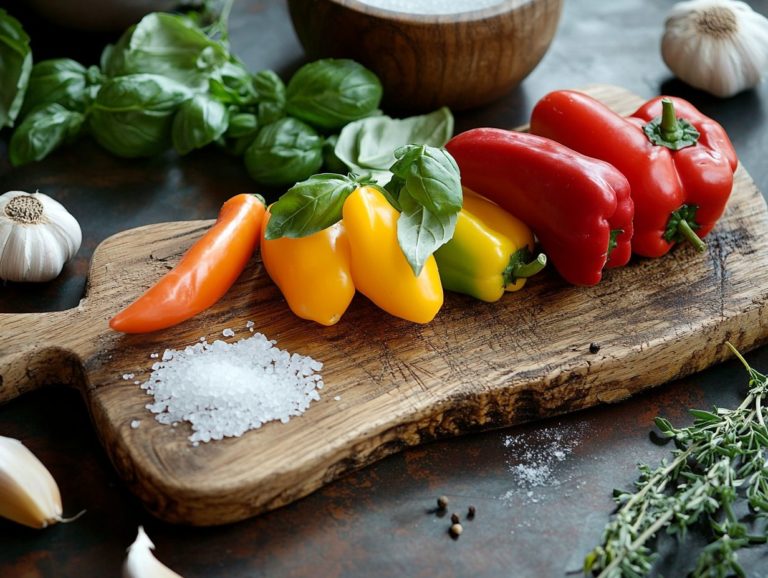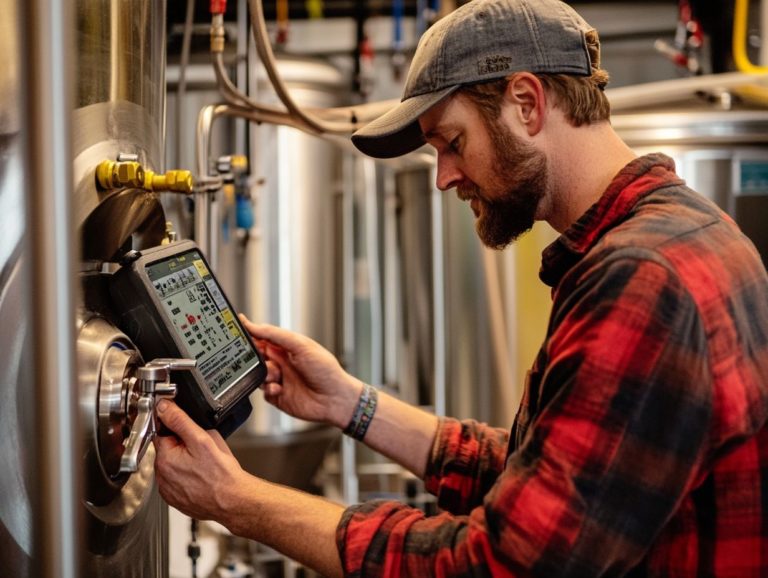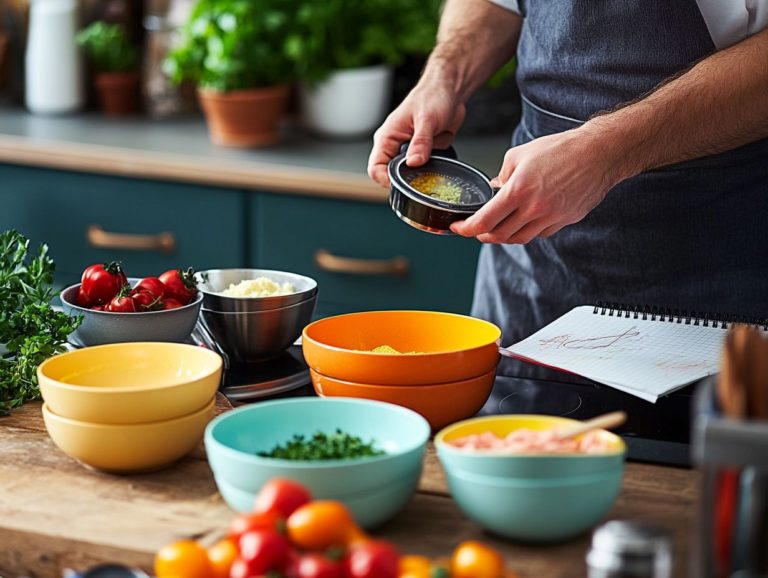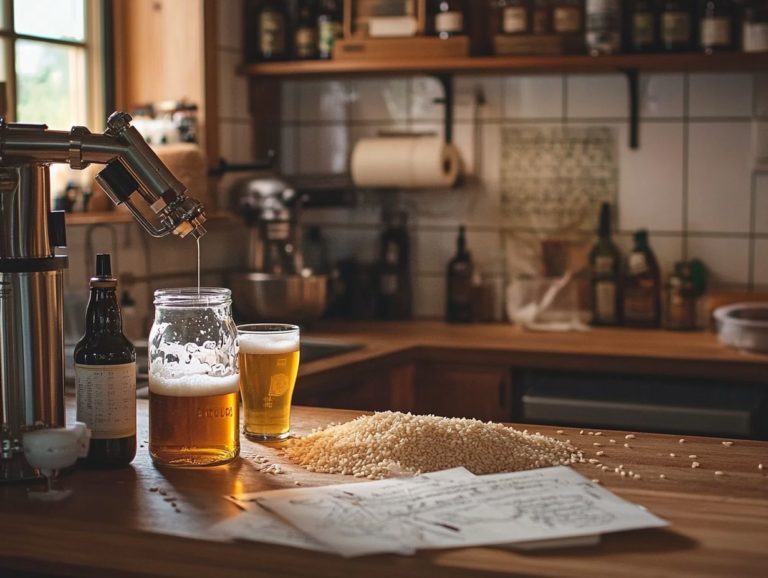5 Ways to Improve Your Brewing Efficiency
Brewing your own beer can be an incredibly rewarding experience. To truly unlock the best flavors and aromas, it’s essential to achieve optimal brewing efficiency and understand core principles of the brewing process.
Discover five vital tips designed to elevate your brewing process. These tips cover everything from perfectly crushing your grains to selecting the finest quality yeast and mastering mash efficiency.
Understand the importance of brewing efficiency and the factors that influence it, including proper water chemistry and mash temperature. Learn how to sidestep common pitfalls that could hinder your efforts.
Whether you’re just starting out or have years of experience, these insights will empower you to take your craft to new heights!
Contents
- Key Takeaways:
- 1. Properly Crush Your Grains
- 2. Use the Right Water-to-Grain Ratio
- 3. Control Your Mash Temperature
- 4. Use High-Quality Yeast
- 5. Monitor and Adjust Your Boiling Time
- What Is Brewing Efficiency and Why Is It Important?
- What Are Some Common Mistakes That Can Affect Brewing Efficiency?
- How Can One Improve Brewing Efficiency in a Homebrewing Setup?
- Tips for Maintaining Consistent Brewing Efficiency
- Frequently Asked Questions
Key Takeaways:
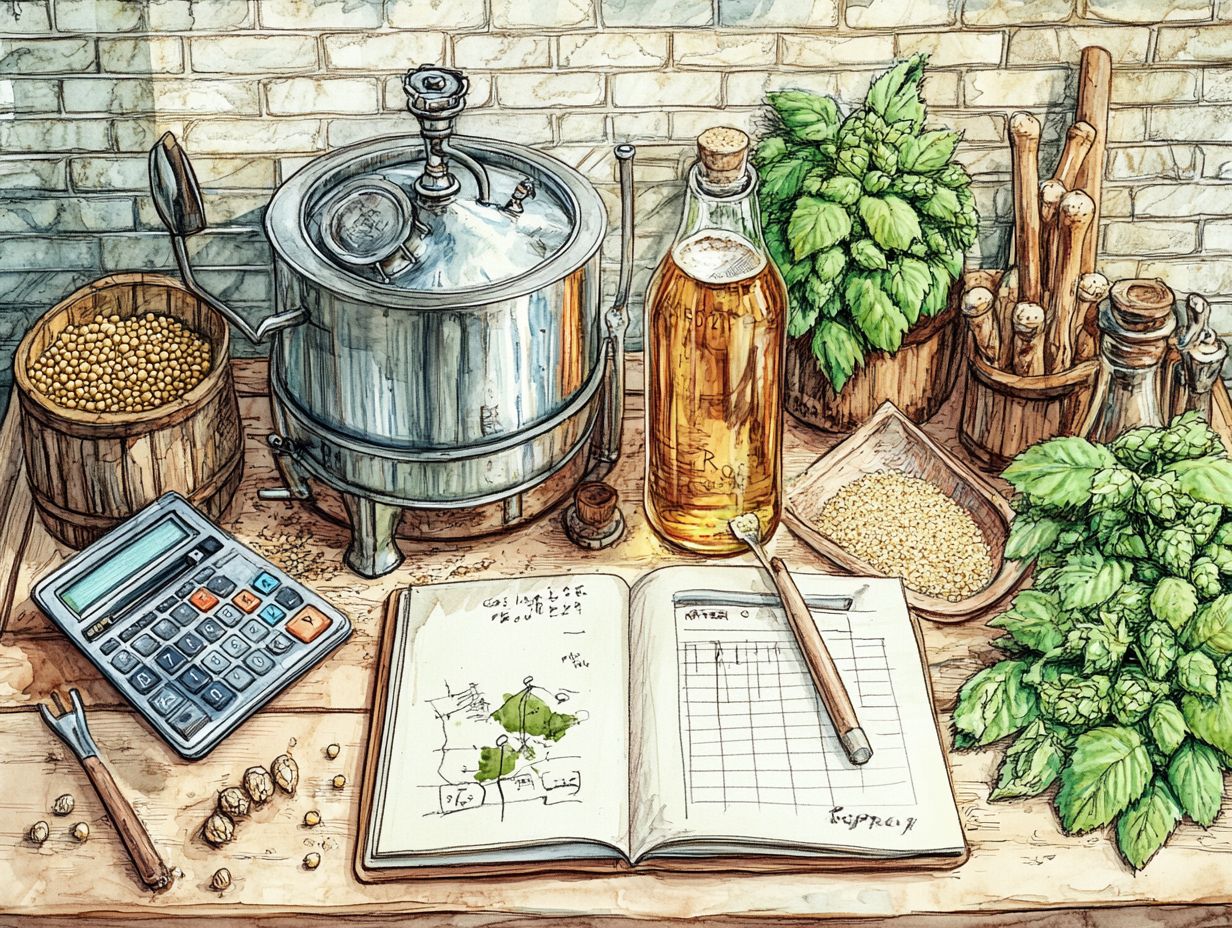
- Properly crushing grains leads to better extraction and efficiency, which directly impacts the quality of your beer.
- The correct water-to-grain ratio is crucial for achieving maximum efficiency.
- Controlling mash temperature ensures the conversion of sugars and optimal efficiency.
1. Properly Crush Your Grains
Crushing your grains is a fundamental aspect of home brewing. It significantly impacts how efficiently fermentable sugars are extracted from the malt.
This process enhances enzyme activity and influences the quality of your beer. Understanding the optimal crush size is crucial for achieving high mash efficiency.
Milling techniques vary, from roller mills to hammer mills. Each method affects the grain’s structural integrity differently.
A finer crush exposes more starch granules, maximizing enzyme action. But be cautious a crush that’s too fine may produce excessive flour, leading to a stuck mash that hinders water flow.
As a homebrew enthusiast, consider your brewing setup carefully. Suppliers like Br u Supply offer various mills designed for different grain types and crush sizes, helping you fine-tune your process.
Regular adjustments will help you find the ideal crush for specific beer styles, ensuring a successful brew day every time.
2. Use the Right Water-to-Grain Ratio
The right water-to-grain ratio is vital for an optimal mash. This balance ensures ideal mash thickness and influences water chemistry.
It directly impacts enzymatic activity, which is crucial for converting starches into fermentable sugars. A typical ratio is about 1.25 to 1.5 quarts of water per pound of grain.
This ratio can vary depending on the specific grain types used, such as adjuncts versus base malts. The brewing method also plays a role.
In systems like BIAB (Brew In A Bag), a slightly higher water-to-grain ratio can help maintain mash temperature. Traditional three-vessel systems allow for more precise adjustments.
By understanding these nuances, you can tailor your water ratios to enhance wort extraction. This will help avoid a stuck mash and optimize infusion times for a superior final product.
3. Control Your Mash Temperature
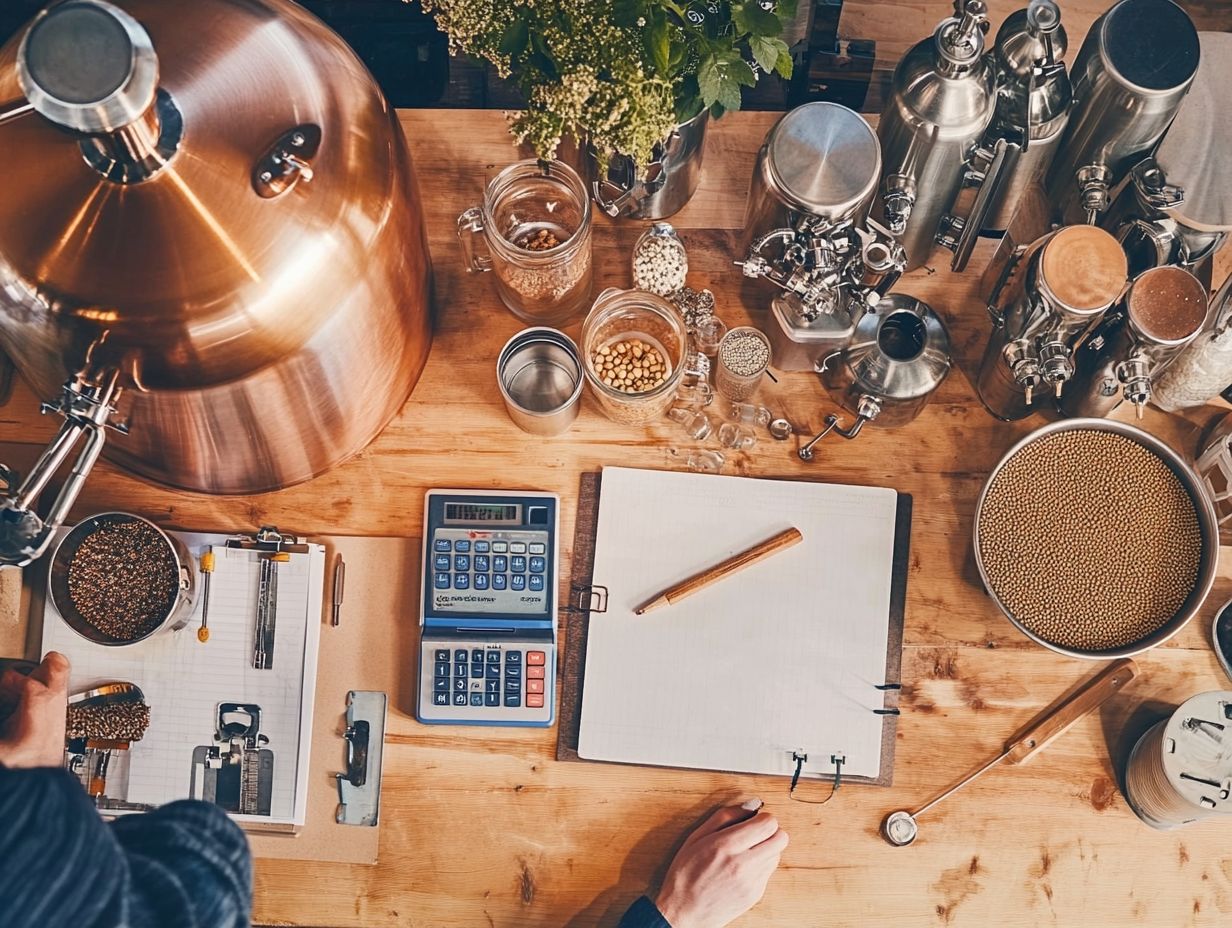
Unlock the secrets of brewing by mastering your mash temperature! Controlling your mash temperature is a pivotal aspect of the brewing process, as it dictates enzymatic activity and influences the development of fermentable sugars.
This ultimately impacts the pH levels and flavor profile of your finished beer. Maintaining specific mash temperature ranges is essential because different enzymes thrive at different temperatures.
For example, alpha-amylase, responsible for breaking down starches into sugars, performs optimally between 70-75 C. In contrast, beta-amylase, which generates fermentable sugars, operates best at slightly lower temperatures, around 60-65 C.
This intricate interplay of enzymes directly affects the efficiency of sugar extraction and the overall taste profile of your brew.
To effectively monitor and adjust these temperatures, you can use digital thermometers and immersion heaters. You can also use sophisticated temperature control systems that automatically regulate heat during the mash process.
These tools give you the power to maintain your desired temperature with precision, ensuring that each batch reaches its optimal flavor characteristics.
4. Use High-Quality Yeast
Using high-quality yeast, like Kveik yeast, is absolutely crucial in your brewing process. It plays a pivotal role in fermentation, affecting the production of fermentable sugars and ultimately shaping the quality and flavor profile of your beer.
Each strain of yeast brings distinct characteristics to your brew. For instance, Belgian yeast tends to produce fruity and spicy esters, adding a complex finish to your beer, while lager yeast ferments at cooler temperatures, resulting in a clean and crisp taste.
Understanding how different strains react to temperature and sugar levels gives you the power to achieve your desired flavor. To optimize your fermentation outcomes, source your yeast from reputable vendors.
This ensures you re selecting strains that are fresh and suited for the type of beer you want to craft. Maintaining optimal fermentation conditions such as controlling temperature and ensuring proper sanitation will further guarantee that you end up with a high-quality product.
5. Monitor and Adjust Your Boiling Time
Monitoring and fine-tuning your boiling time is essential for maximizing brew house efficiency and ensuring optimal wort extraction, which directly impacts the flavor, aroma, and overall quality of the beer you produce.
A longer boil will typically ramp up bitterness, while a shorter boil might yield a more delicate hop presence. To achieve that perfect balance, consider using a timer to mark key intervals, which allows you to make precise hop additions at different stages of boiling.
Controlling the boil intensity can enhance essential traits in your beer, such as clarity and stability, ultimately leading to a more refined end product that you can be proud of!
What Is Brewing Efficiency and Why Is It Important?
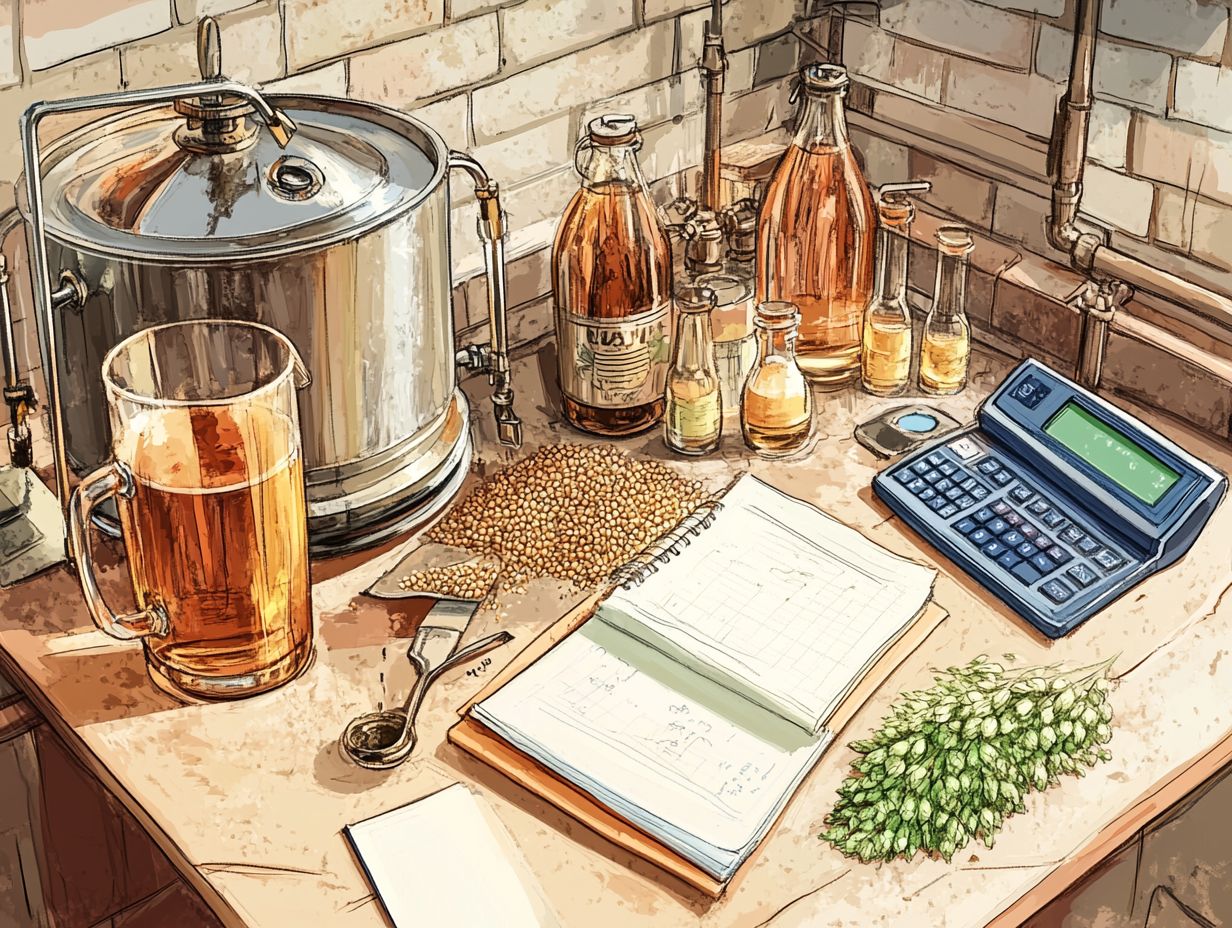
Brewing efficiency refers to how effectively your brewing system transforms raw ingredients into fermentable sugars, which ultimately leads to beer. This aspect is crucial for home brewers, as it directly impacts both the yield and quality of your final product.
By understanding brewing efficiency, you can optimize your brewing processes, enhancing your brew house performance and ensuring consistent results while minimizing waste.
This efficiency is vital for every home brewer eager to create exceptional beer without incurring unnecessary losses. Several factors can significantly affect your brewing efficiency, such as mash temperature, pH levels, and the types of grains you select. The equipment you choose also plays a crucial role; whether it s mash tuns or sparging techniques, each component impacts how effectively ingredients are converted during brewing.
By monitoring key metrics like specific gravity and utilizing tools like brewing software, you can track your brewing efficiency more accurately. Identifying areas for improvement not only elevates your brewing experience but also leads to richer flavors and a more rewarding final product.
What Are the Factors That Affect Brewing Efficiency?
Several factors influence your brewing efficiency, including how well the mash process works, water chemistry, mash temperature, and the quality of ingredients. Each of these elements is critical in enhancing both the effectiveness of your brewing process and the overall quality of the beer you produce.
Carefully adjusting your mash efficiency is essential for maximum sugar extraction from the grains, which significantly impacts both the alcohol content and flavor profile of your beer. Water chemistry, including levels of calcium and bicarbonate, affects enzyme activity during mashing. The precise mash temperature determines how well starches convert into sugars, influencing your brew’s sweetness. Optimizing sparging techniques can further enhance your brewing efficiency.
By using fresh, high-quality ingredients like hops and yeast, you can elevate your brewing outcome, ensuring vibrant and well-rounded flavors. Additionally, utilizing equipment like a grain mill or fermenter further optimizes your process.
Understanding and optimizing these components not only boosts your home brewing efficiency but also enhances the final product, resulting in a craft beer you can proudly share.
How Can One Measure Brewing Efficiency?
Measuring brewing efficiency involves assessing how well you’re extracting wort and the total amount of fermentable sugars produced during the brewing process. This evaluation helps you gauge your performance and identify areas for improvement, enhancing your brewhouse efficiency.
To accomplish this, you typically calculate efficiency using a percentage formula that compares the actual yield of fermentable sugars to the potential yield based on the grain’s specifications. This efficiency percentage serves as a benchmark for your brewing process, highlighting the importance of accurate measurements and pH levels for achieving optimal results.
When you make precise assessments, you can fine-tune your techniques to ensure each batch consistently delivers quality and flavor while minimizing waste and maximizing resource utilization. Thus, grasping and enhancing brewing efficiency is essential for both aspiring and seasoned home brewers alike.
Ready to boost your brewing efficiency?
What Are Some Common Mistakes That Can Affect Brewing Efficiency?
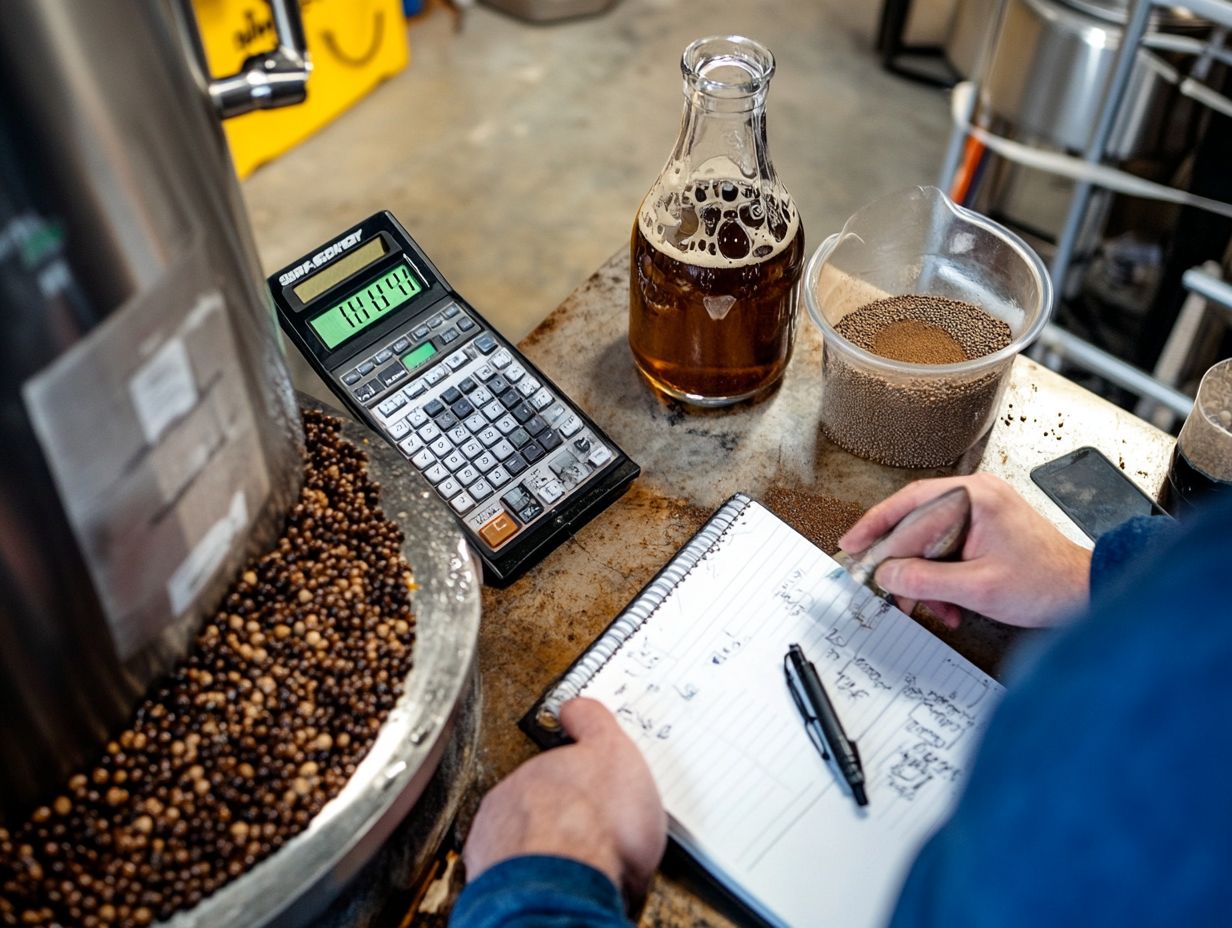
Common mistakes that can hinder your brewing efficiency include improper mash temperature management, suboptimal water chemistry, inadequate grain milling techniques, and skipping the crucial mash-out step. Each of these factors can lead to lower fermentable sugars and ultimately compromise the quality of your beer.
You might often underestimate the importance of maintaining a consistent mash temperature. This is essential for the enzyme activity that converts starches into sugars. Neglecting water chemistry can create imbalances that alter your beer s flavor profile and mouthfeel. Failing to mill your grains properly can restrict access to the starchy endosperm necessary for fermentation.
To address these concerns, it s wise to invest in effective temperature control systems. Test and adjust your water chemistry using brewing salts. Ensure your grain mill, such as the Barley Crusher, is set to achieve the ideal crush size. By concentrating on these key aspects, you can significantly elevate the quality of your brews while maximizing efficiency.
How Can One Improve Brewing Efficiency in a Homebrewing Setup?
Improving brewing efficiency in your homebrewing setup can be accomplished through a variety of strategic approaches. Consider optimizing the mash process and fine-tuning your water chemistry. Employing effective water rinsing techniques can enhance your extract yield.
Using advanced brewery equipment can significantly improve your brewing process. Experimenting with mash thickness is one excellent method to boost efficiency. A thicker mash can lead to higher temperatures, increasing the enzymatic activity necessary for better sugar conversion.
Assessing and adjusting your water chemistry can dramatically impact your brew. Different grains like Rye or amber ales require specific ions like calcium or magnesium to unlock their full flavor and fermentability.
Refining your water rinsing techniques whether using a slow rinse to minimize channeling or employing a rinse method can significantly enhance your efficiency as well. Creating an even grain bed during rinsing can prevent channeling and increase extraction.
As a homebrew enthusiast, actively test these adjustments in your brewing process. Discover the optimal combinations for the best extraction and elevate your brewing game.
Tips for Maintaining Consistent Brewing Efficiency
Maintaining consistent brewing efficiency calls for a systematic approach. Monitor critical parameters like water chemistry, mash temperature, and fermentation conditions. This attention to detail ensures uniformity in your brewing process and results in high-quality beer production, comparable to the standards of Br u Supply.
To achieve this, invest in reliable brewing tools and equipment that allow for precise measurements. Regularly check and record these metrics. Doing so will help you identify trends and assist in troubleshooting any unexpected deviations during your brewing cycle.
Using quality ingredients such as Kveik yeast can also improve consistency. Keeping detailed logs of each batch can provide invaluable insights, leading you to improved methods and recipes over time.
Along with diligent measurement practices, perform routine maintenance on your brewing equipment. This ensures everything operates efficiently and minimizes the risk of contamination, preserving the integrity and beer quality of each brew you create.
Frequently Asked Questions
Don’t wait to elevate your brewing game; make these changes today for better beer tomorrow! Share your tips or experiences in the comments or on social media to foster engagement.
What are 5 ways to improve your brewing efficiency?
Brewing efficiency can significantly enhance your beer’s taste and quality. Here are five essential tips to improve your brewing process:
1. Use high-quality ingredients: Fresh, high-quality ingredients are your secret weapon for brewing better beer!
2. Maintain proper sanitation: A clean brewing space prevents contamination. Keep your equipment spotless for a successful brew.
3. Control the temperature: Temperature is crucial in brewing. Keep it consistent throughout the process; consider using CO2 monitoring for best results.
4. Use the right amount of water: The balance of water to grain is key. Follow the recommended ratio to achieve optimal extraction during brewing.
5. Properly crush your grains: Crushing grains to the right size maximizes flavor and fermentable sugars. Buying grains from suppliers with free shipping can save you money!
Start implementing these tips today and taste the difference in your next brew!


